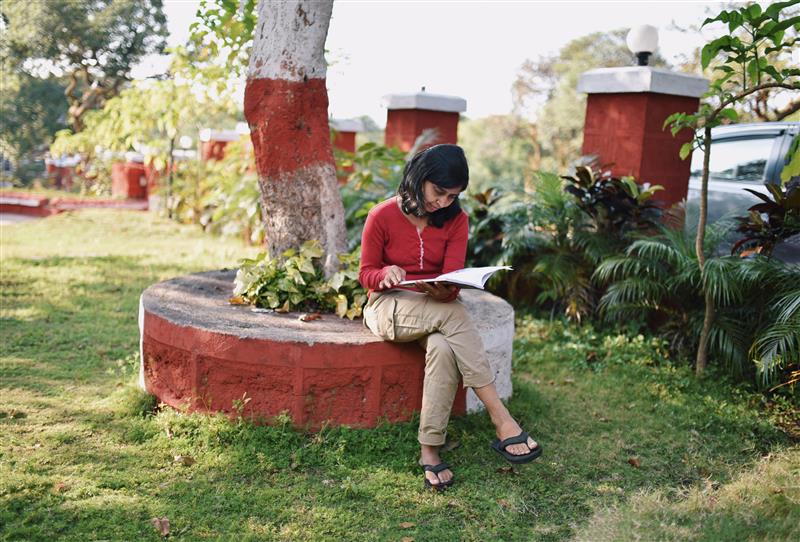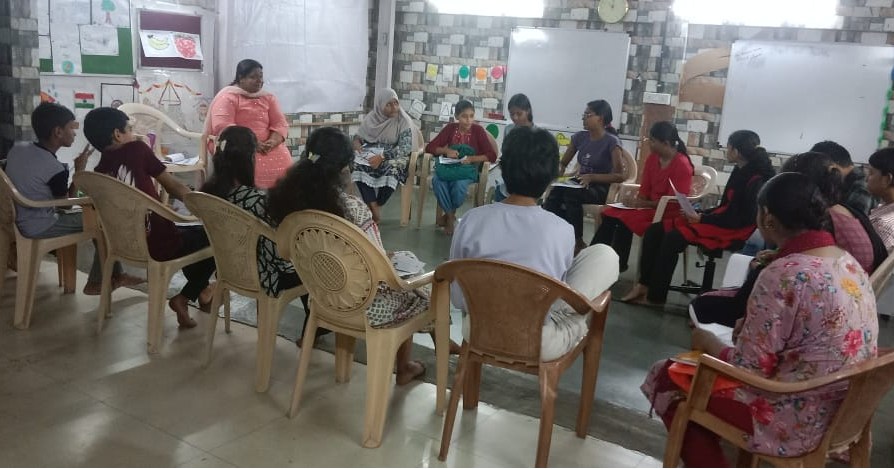Betwixt youth aspirations and post-schooling futures
Despite increased participation in schooling post the RTE Act, young people from socio-economically marginalized families continue to approach education as a ‘gamble’. The article discusses the role that the development sector can play, by investing in their ‘capacities to aspire’ for a more secure future.

On May 2, 2025, the SSLC results were announced in Karnataka. On my way to the railway station, I learnt that Justin*, my cab driver’s son, had scored 65 percent. Not impressed, Justin’s father kept reiterating that he should have done better but had got distracted by ‘bad company’. Now he was determined to put his son, a first- generation learner, in a hostel so he could focus on his studies.
However, the costs of higher education and hostel seemed daunting. A Dalit Christian, he hoped to convince ‘fathers’ of a minority educational institution to admit his son with a concession. To reassure him and provide some guidance, I asked about Justin’s subject preferences and scores. But Samy dismissed this thought stating “What is there, madam? Let him do PCMB. Then we will see. First, he should work hard and do well. Then we can work out the rest.”
A mismatch between youth aspirations and educational opportunities
Working in the field of youth and education for over a decade now, I am struck by how common such responses are. This is especially the case amongst socio- economically disadvantaged youth and their families, with respect to their post-schooling futures. Across urban and rural geographies, ‘Somehow just pass’, without a clear pathway for the future, is a common refrain I have heard from students, teachers and other adults working with socially disadvantaged youth.
The Right to Education Act (2009) has pushed enrolment to universal levels at elementary stage and to over 85 percent at the secondary level (ASER, 2023). Since 2009, there has also been an impetus toward skilling youth for self-employment. Vocational education and skilling received a push with the introduction of the National Skills Development Policy, National Skills Qualification Framework and Vocationalization of Secondary and Higher Secondary Education, under the Rashtriya Madhyamik Shiksha Karyakram. For students ‘at-risk’ of dropping out, these policies are envisioned to provide opportunities for flexible acquisition of education and skills relevant to future employment (Maithreyi et al., 2019).
Yet, the extant body of educational research in India has shown how none of these guarantees match the students’ aspirations. Neither have these been borne out in terms of securing socially disadvantaged students’ post-schooling futures. The reasons for this are several. These include deficits in availability of decent jobs (ILO, 2024), expectations on youth to personally invest in ‘upskilling’ and ‘soft skilling’ to become ‘employable’ (Maithreyi, 2021). Poor returns on vocational education, which remains non-aspirational (Maithreyi et al., 2019), inaccessibility of privatized higher education (Jamkar and Johnstone, 2024; Khan, 2017), and the lack of information, knowledge or guidance for first generation learners to pursue post-schooling opportunities are also important factors.
Building the ‘capacity to aspire’: role for the development sector
The state’s commitment to addressing these glaring structural deficits, through better educational provisioning and creation of decent jobs, will remain pivotal. However, there is perhaps also a role for civil society and the development sector to play in improving prospects for youth. At the very outset, what is needed is an investment in young people’s ‘capacity to aspire’ (Appadurai, 2004), which schools often fail to cultivate.
Building young people’s capacity to aspire entails expanding their cultural repertoire of knowledge and experience, which can contribute to increasing their limited aspirational maps and pathways, multi-fold. As the anecdote above and other field experiences show, the socially disadvantaged and their families approach education largely as a gamble. The lack of quality, support and guidance within the education system, often results in socially disadvantaged youth dropping out as a result of education being incommensurate with their everyday lives.

What is needed are programs that empower – youth to safely interrogate and understand social structures and identities, acquire confidence and learn agency, critical thinking, leadership and negotiation skills. These programs can help youth in imagining and working towards alternate futures that can be personally meaningful and rewarding. Across rural and urban geographies, case stories of young girls and boys demonstrate their negotiations for higher education, and jobs, despite structural barriers of poverty and caste or early marriages, when supported to critically engage with their contexts. Youth reveal great enterprise with greater exposure, for example, by using art-based or sports-based methodologies of empowerment programs, to competitively positions themselves for jobs. These also help them in adopting skills training programs to score better in SSLC and have ‘back-up’ options in case their educational aspirations remain unattainable. By drawing upon language, jargon and exposure, these programs help them develop their cultural capital (Maithreyi, 2021; 2025).
Critical engagements with youth on livelihoods and local democracy
Livelihood and employment remain the biggest concerns and challenges for youth today, particularly for educated youth. Within this context, youth are urged to be entrepreneurial and enterprising in finding opportunities for self-employment. Otherwise, they are pushed to contribute through their aesthetic labor within the urban service economy, which offers temporary and casualized jobs. To counter these insecure pathways to the future, youth require a grounded understanding of sustainable livelihood options. Such an understanding must help them work through important questions of identity, political economy, climate stress and labor rights in making dignified choices.
Building the capacity to aspire must embed engagements with questions of secure and dignified livelihoods. This must enable youth to critically think through the intersections of livelihood and caste, class, gender, climate and health, in order to cultivate their capacities to negotiate for decent work. Building an understanding of collective rights and commons and collective bargaining in the face of exploitative capitalism remains foremost issues to be addressed by those of us in the development sector who intervene with a social justice lens, in support of better youth futures.

Another key aspect to better futures for young people is political participation through greater engagement with a vibrant, local grassroots democracy. Young people’s participation is vital to strengthen democratic structures at the grassroots level. It is also critical to preserve the fabric of democracy, secularism, equity and social justice, which must form the core of our nationalist sentiments. Now, more than ever, there is an urgent need to reclaim the nationalist discourse through greater engagement with youth and their understanding of these values.
The workings of democracy and an understanding of constitutional provisions for people’s participation remain the biggest gap within the education system today. Education has largely become an enterprise of individualistic development for serving capitalistic agendas. In this context, young people’s understanding of and capacities to participate in local governance (e.g., through Gram Sabhas or Special Gram Sabhas) remains unaddressed. There is tremendous scope for young people to hold their local governments (i.e., Panchayats) accountable, and place demands for improved educational opportunities and the creation of jobs. There is also a space for them to participate in social audits to improve the implementation of guaranteed schemes.
Conclusion
These pathways for participation are not hypothetical. All of these have been demonstrated by the youth we have worked with. Developing young people’s knowledge and leadership capacities to ensure improved governance and greater accountability is therefore another key area for civil society to work upon.
None of these interventions may directly contribute to post-secondary education or employment. However, what such offerings provide is an opportunity to gain a more rounded education. This will help build a more secure future, at a time when schools are increasingly becoming narrowly instrumental.
References
Banerji, Rukmini. From RTE 2009 to NEP 2020: policies, practices and progress towards equipping youth for the future. ASER Centre, 2023.
International Labour Organization (ILO). India employment report 2024: youth employment, education and skills. New Delhi: ILO Decent Work Support Team for South Asia and Country Office for India, 2024.
Jamkar, Vidya, and Christopher Johnstone. “Privatisation and unequal access in India.” International Higher Education, October 4, 2024.
Khan, Khursheed. “The impact of privatization on access to higher education among social and income groups in India.” Artha Vijnana: Journal of the Gokhale Institute of Politics and Economics 59, no. 1 (2017): 34–54.
Kumar, Krishna. “Vocational education: tangled visions.” Norrag News 46 (2011): 35–36.
Maithreyi, R. “Learning to service: vocational training for marginalized youth, aspirations, consumption, and social reproduction.” Querying childhood: feminist reframings, edited by Mary E. John, Barbara Lotz, and Elizabeth Schömbucher, 190–209. Oxon: Routledge, 2025.
Maithreyi, R., K. Prabha, A. Iyer, S. R. Prasad, and J. Jha. A critical sociological analysis of the skills development initiative of India. Bangalore: Centre for Budget and Policy Studies, 2019.




No approved comments yet. Be the first to comment!